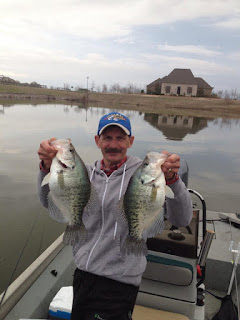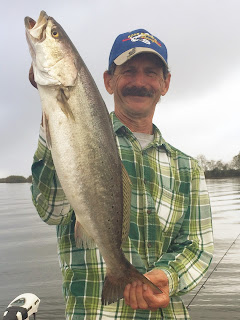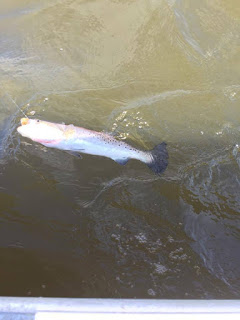101 Ways to Catch Crappie
Ok there aren't 101, but they do have a bunch. So here is the list that I know. You may have something new that is not covered in this blog;
1. Single long pole tight lining with a jig or live bait. By long pole I mean 9-12 feet.
2. Single long pole using a cork;slip cork; or clip on cork with a jig or live bait.
3. Casting rod; can be spinning, bait cast, or spin cast using a jig, spinner, crank bait etc. With or without a cork also.
4. Shooting docks; this is usually done with a medium to light action spinning rod in which the bait is sling-
shotted under a dock or camp. The technique is to bend the rod by holding the bait and then releasing it to "shoot" under the structure.
5. Spider rigging; This is done by setting poles in front of your boat in a fanned out position. Typically 8 poles or more from 12-16 feet are used. In some cases shorter rods can be used also. Some states have regulations on the number of poles that can be used, so please check the regulations before you go.
6. Long lining; This technique is where you pull 1 or more baits behind the boat. Jigs or live baits are usually used with or without a cork. A drift style method is normally used or slow troll with your trolling motor. This also works great in small lakes and ponds.
7. Pulling cranks; This technique is when you attach crank baits to trolling rods which can vary in length behind the boat propelling, either with your outboard or trolling motor. Trolling speed depends on water depth and the location of the fish. Lure size and presentation also depends on depth and location of the fish.
8. Side Pulling; this is very similar to spider rigging, but instead of a front presentation, the rods are set on the side of the boat in multiple rod holders. The trolling motor is also mounted to the side of the boat . Rod lengths are a matter of preference, but most are shorter than a typical spider rig.
9. Fly fishing; Normally a light weight 4,5, or 6 weight fly rod and line are used with a sinking line. Although if the fish are shallow a floating line can be used. There are a variety of flies that can be used, from nymphs, jigs, or clousers. These can be used with a strike indicator aka cork.
10. Two pole tight lining; This is what I termed the Poverty Point two pole method. On my first voyage to this small lake in Delhi Louisiana, I noticed just about all the locals were holding a rod in each hand and using a foot controlled trolling motor, tight lining around the many structures in the lake.
11. Long polling docks; Similar to shooting docks but instead you lay flat in front of the boat and tight line . Works well if you are by yourself and at times easier than shooting. A 12 foot crappie pole works well for this method.
12. Night Fishing; With or without a light, using many of above techniques.
13. Yo Yos; Some places do not allow these, so please check your regulations. This is a spring loaded device attached to docks or trees that is baited with live bait and snatches the fish when it bites. 14. Ice fishing: Not exactly a southern thing, but interesting to see how it is done. Drilling a hole or many holes, then dropping a transducer from fish/depth finder to see if the fish are there. Using a specially designed rod, then dropping a jig or spoon to catch crappie and other assorted fish. 15. The cane pole: Tying a line to a cane reed with a cork, split shot and a hook, with live bait, usually a minnow. Brings back good memories and is still used today. Who knew you could use so many methods to catch one fish.
Good luck fishing . Hope to see ya on the water.




Comments
Post a Comment